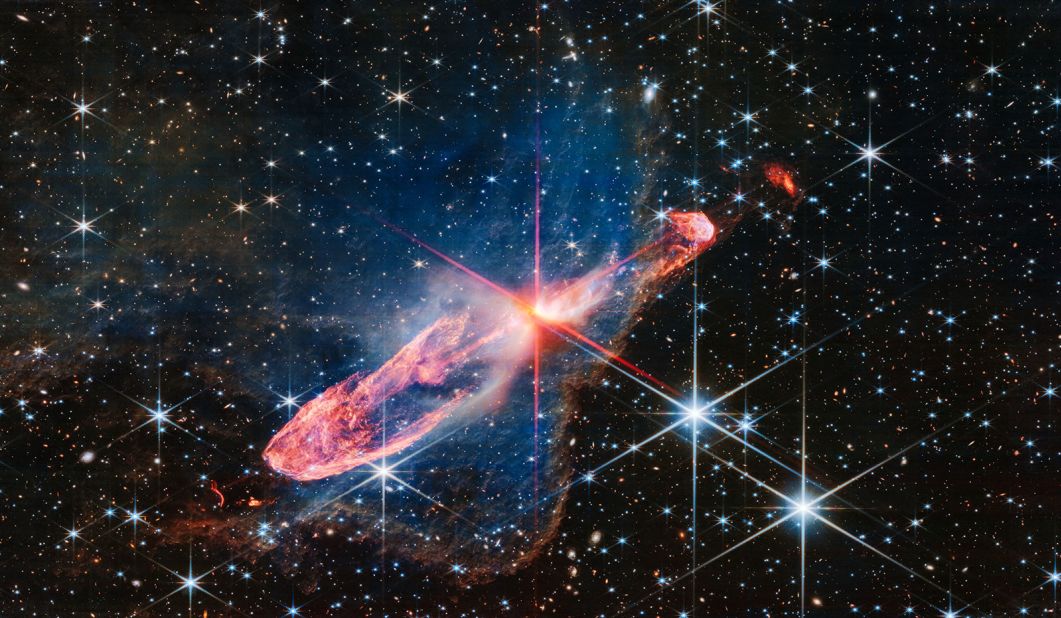Why Ring Nebula in news?
Astronomers used the James Webb Space Telescope to capture this striking new image of Messier 57, more popularly known as the Ring Nebula. The nebula in the image is actually the glowing remains of a sun-like star and at its centre is the star’s hot core, which is called a white dwarf.
The Ring Nebula, a stunning cosmic jewel, represents the final stages of a star’s life and provides essential insights into stellar evolution. Its colorful and distinct appearance makes it a favorite target for amateur astronomers, while professional observatories offer detailed views of its intricate structure. As one of the most iconic planetary nebulae in the night sky, the Ring Nebula continues to fascinate both scientists and stargazers alike, enriching our understanding of the cosmos.
Details of Ring Nebula
The Ring Nebula, also known as Messier 57 or M57, is one of the most famous and visually striking objects in the night sky. Located in the constellation Lyra, approximately 2,000 light-years away from Earth, the Ring Nebula is a planetary nebula formed from the remnants of a dying star.
Formation and Structure of the Ring Nebula
Stellar Evolution
- The Ring Nebula was once a main-sequence star, similar to our Sun, that exhausted its nuclear fuel.
- As the star’s core ran out of hydrogen, it underwent a series of nuclear fusion reactions, causing it to expand into a red giant.
Shedding Outer Layers
- In the red giant phase, the star expels its outer layers into space through powerful stellar winds.
- These expelled layers form an expanding shell of ionized gas and dust, creating the iconic ring-like structure.
James Webb Telescope
- The James Webb Space Telescope (JWST) is a revolutionary space observatory and one of NASA’s most ambitious and complex missions.
- It is designed to be the successor to the Hubble Space Telescope and promises to significantly enhance our understanding of the universe.
- The JWST is a collaboration between NASA, the European Space Agency (ESA), and the Canadian Space Agency (CSA).
Key Features and Objectives
- Advanced Technology: The JWST features state-of-the-art technology, including a large segmented mirror, which is 6.5 meters (21.3 feet) in diameter, and four advanced scientific instruments. The telescope is designed to operate in the infrared range, enabling it to see through dust clouds and observe distant objects with greater clarity.
- Deep Space Exploration: The primary objective of the JWST is to explore the distant universe, including the formation of the first galaxies, stars, and planetary systems. It will peer back in time to observe celestial objects that formed shortly after the Big Bang.
- Studying Exoplanets: The JWST will study exoplanets, planets orbiting stars beyond our solar system, to characterize their atmospheres and potential habitability. It will help astronomers search for signs of life on other planets and understand the diversity of exoplanetary systems.
- Understanding Star and Galaxy Formation: By observing star-forming regions and distant galaxies, the JWST will provide insights into the processes that govern the formation and evolution of stars and galaxies throughout cosmic history.
- Investigating Solar System Objects: The telescope will also study objects within our solar system, such as asteroids, comets, and the outer planets. It will contribute to our understanding of the solar system’s origins and evolution.
Launch and Deployment
- The JWST was launched on December 25, 2021, aboard an Ariane 5 rocket from the Guiana Space Centre in French Guiana.
- The telescope is currently positioned at the second Lagrange point (L2), located about 1.5 million kilometers (nearly 1 million miles) from Earth.




 Which District of Uttar Pradesh is Known...
Which District of Uttar Pradesh is Known...
 Daily Current Affairs 08th October 2025,...
Daily Current Affairs 08th October 2025,...
 Top-10 Indian States with the Highest Da...
Top-10 Indian States with the Highest Da...

